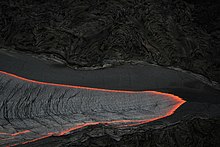Pāhoehoe lava
Pāhoehoe Lava ( hawaiian Pāhoehoe ) is the name for a low viscosity (ie low viscosity ) basaltic lava high temperature and flow rate as well as low silica content , which has a relatively smooth surface after solidification. The term was introduced into geological terminology by Clarence Dutton and was originally only used for solidified lava. In more recent sources, flowing lava flows are also referred to as Pāhoehoe (lava) .
The very hot lava flows under a horizontal solidifying crust, which often breaks into individual clods, rises up in ridges of lava or slides apart and leaves lava pillows. While the lava flows are still active, the already solidified lava blanket can be up to 50 cm thick. This can cause lava tubes to form.
In contrast to the viscous ʻAʻā lava , the surface is quite smooth, so that it can be easily walked on after cooling.

Alternative names are Fladenlava, Schollenlava, Wulstlava, Gekröselava, Seillava or Stricklava . The name "Stricklava" has its origin in the external shape of the lava, the surface of which is structured like a knitted pattern. This is caused by the fact that when the lava slowly drains off, a kind of skin is created on its surface, under which the thin lava continues to flow and shifts the skin.
literature
- Clarence Edward Dutton: Hawaiian volcanoes . In: US Geological Survey annual report of the director , Vol. 4, 1882/83, Washington 1884, pp. 81-219. WorldCat
Individual evidence
- ^ Pāhoehoe in Hawaiian Dictionaries
- ↑ Ulrich Knittel: Info sheet Vulkanite , Leipzig: Klett, 2005 (date of processing: June 12, 2012)
- ^ Pahoehoe-Lava in the Lexicon of Geosciences , Heidelberg: Akademischer Verlag, 2000
- ↑ James Furman Kemp: A handbook of rocks for use without the microscope: with a glossary of the names of rocks and other lithological terms . New York: D. Van Nostrand, 1929, p. 258 : CE Dutton, 4th Annual Report US Geological Survey , 1883, p. 95; Bulletin of the Geological Society of America, Volume 25 / Geological Society of America. 1914, p. 639
- ↑ James Furman Kemp: A handbook of rocks, for use without the microscope , New York: D. Van Nostrand company, 1929, p. 258
- ↑ cf. Global Volcanism Program 1991. Report on Kilauea (United States) , In: McClelland, L (ed.), Bulletin of the Global Volcanism Network, 16:11. doi : 10.5479 / si.GVP.BGVN199111-332010 . Smithsonian Institution: On November 18, tubes covered the immediate vent area, pahoehoe flowed in the channel to 610 m, then sluggish aa to 550 m.
